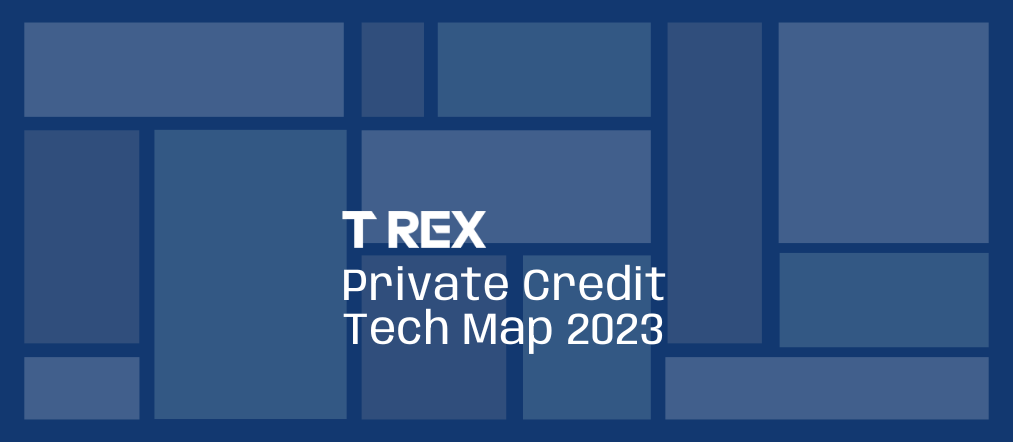T-REX’s 2023 Market Map examines the dynamic landscape of technology within the private credit industry. The map offers a visual representation of the evolving ecosystem, capturing the key players and their respective technologies that are shaping the future of private credit.
The private credit market is experiencing significant growth and transformation, driven by various factors such as the expansion of the global middle class, increased demand for credit from small and medium-sized businesses, and regulatory changes that have facilitated institutional investment in private credit. As we look towards the second half of 2023, several trends are emerging in the market, shaping the landscape of private credit technology and investment opportunities.

Trend 1: The Expansion of the Global Private Credit Market
During recent economic uncertainty and rising interest rates, the majority of large global banks have tightened their risk appetites. Banks have had to become increasingly selective in their deployment of capital to ensure that their balance sheets are not put under too much pressure. Private credit funds have stepped in to fill the funding gap, supporting those who are vulnerable to the lower availability of bank lending and in need of a more flexible credit structure.
Led predominantly by the U.S. and Europe, the global private credit market is expanding rapidly, presenting a wealth of new opportunities for investors. The private debt market has grown more than six-fold since the Global Financial Crisis of 2007-2008, with senior lending strategies experiencing the most robust growth.
Today, the private credit market stands at $1.4 trillion and is estimated to grow to between $1.7 and $1.9 trillion by 2025. This expansion brings more sophistication to transactions, attracting even more investors who want to participate in this growing market. The increased interest and participation of those investing in private credit have led to the emergence of various players in this quickly evolving and thriving industry.
Trend 2: The Increasing Importance of Data Analytics in Managing Risk
As the private credit market expands, effective, scalable data analytics are becoming increasingly crucial for funds to evaluate investment opportunities effectively. Investment teams are faced with the challenge of analyzing a growing number of opportunities, and they require powerful tools to assess risks and potential returns accurately. Moreover, the key to higher risk, higher yield investment strategies is vital, robust data analytics that can help calculate the risk associated with higher returns.
Investors looking to enter the private credit investing space demand access to tools as powerful as those available in the public markets, such as Bloomberg, T-REX, and Cap IQ. The strength of this wider market demand is forcing technology providers to develop new tools in response. At present, there are few tools sufficiently sophisticated to provide valuable insights into the underlying data, but companies are swiftly seeking to adapt their software production to better support investors and help to ensure that they feel confident when investing in private credit. As we look to the remainder of 2023 and beyond, the availability of raw data and advanced analytics solutions tailored to private investments is becoming more critical.
Trend 3: Growing Complexity of Structures in Private Credit
Private credit structures have evolved significantly over the past decade. What was once a market primarily built on handshakes at conferences has now transformed into an intricate landscape with all the hallmarks of complex fixed income including variable rates, tranches, and other sophisticated elements. The increasing flow of capital into private credit has necessitated the development of powerful technology solutions capable of handling these complicated details.
The market map reveals a rising number of companies emerging to support both risk management (e.g. Moody’s Analytics, Trepp, and Thomson Reuters) as well as holistic portfolio management (e.g. Clearwater Analytics and Broadridge). In addition, large market players like State Street and Cap IQ are increasingly offering specialized private credit solutions to help meet this burgeoning market demand. These advancements in technology help manage the growing complexity of structures and provide investors with the necessary tools for effective decision-making.
Trend 4: Rise of ESG Investing
ESG (Environmental, Social, and Governance) investing has gained significant traction across various industries, and the private credit market is no exception. Investors are increasingly interested in allocating their capital to private credit funds that exhibit strong ESG practices. The growing importance of ESG factors is reflected in the market map, as companies like Novata, MSCI, and Refinitiv help to lead the way in ESG Reporting.
As investors become more aware of the impact of their investments on the environment and society, ESG considerations will continue to shape investment decisions in the private credit space. It is now clear to all market participants that this intersectional trend is just as relevant to investing in private credit as it is to any other part of the financial services industry.
Private Credit Trends Through The End of 2023 and Into 2024
The private credit market is experiencing rapid expansion, accompanied by advancements in technology and evolving investment tastes. The increasing importance of data analytics, the growing complexity of structures, and the rise of ESG investing are all shaping private credit market trends through the end of 2023. As the market continues to evolve, investors and industry experts must stay abreast of these trends to navigate the dynamic opportunities and challenges within the private credit market.
Learn more about how T-REX’s powerful data management and analytics suite is built with the private credit market in mind.
